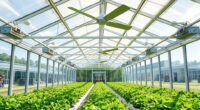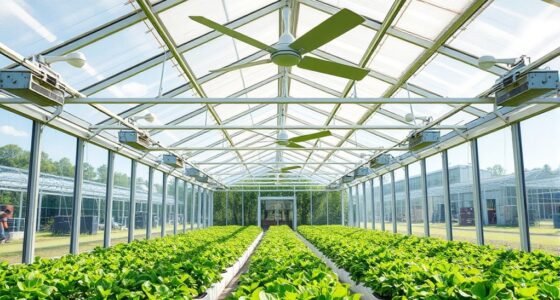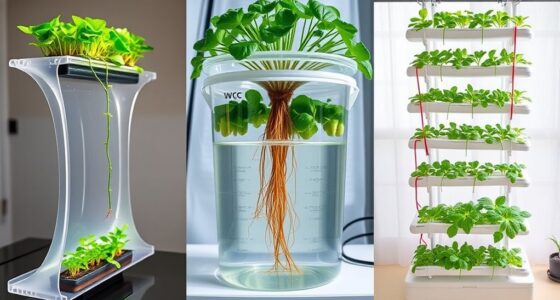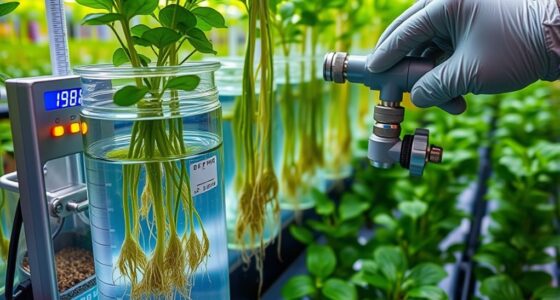To manage evaporation and water loss in your outdoor hydroponic garden, monitor soil moisture regularly and use covers to retain humidity. Implement shading, windbreaks, and natural covers to reduce temperature and wind effects that accelerate water loss. Adjust your setup based on weather conditions and maintain consistent watering practices. By controlling these factors, you’ll keep your plants healthy and conserve water efficiently. Stay with us to discover even more effective strategies for ideal garden management.
Key Takeaways
- Use shading techniques and windbreaks to reduce temperature and wind exposure, minimizing evaporation rates.
- Cover hydroponic setups with UV-resistant, transparent materials and ventilate periodically to prevent mold and humidity buildup.
- Maintain consistent soil moisture through regular monitoring and timely replenishment to prevent over-evaporation.
- Implement moisture sensors and touch tests for real-time moisture assessment, ensuring optimal water levels.
- Choose shaded or sheltered garden locations to protect against hot, windy conditions that accelerate water loss.

Outdoor hydroponic gardens face the challenge of water loss primarily through evaporation, which can reduce nutrient availability and hinder plant growth. When water vapor escapes from your system, soil moisture levels drop, making it harder for plants to absorb the nutrients they need to thrive. Managing this water loss requires a combination of effective soil moisture management and climate control strategies to keep your plants healthy and productive.
Outdoor hydroponic gardening faces water loss challenges that impact plant health and nutrient absorption.
First, you need to monitor soil moisture carefully. Regularly checking the moisture levels helps you understand when to add water and prevents your plants from becoming stressed due to drought conditions. Using moisture sensors or simple touch tests can give you real-time insights. When soil moisture drops too low, it’s essential to replenish it promptly to maintain a stable environment for your plants. But simply adding water isn’t enough; you also have to consider the climate conditions that influence evaporation rates.
Climate control plays a crucial role in reducing water loss. On hot, windy days, evaporation accelerates, stripping moisture from your soil and nutrient solutions. To combat this, you can implement shading techniques, such as shade cloths or planting taller crops nearby to provide natural cover. These methods help lower the temperature and reduce direct wind exposure, which in turn minimizes water loss. Additionally, windbreaks or barriers can shield your garden from harsh breezes that speed up evaporation.
Another key aspect of climate control involves managing humidity levels. If the air around your garden is too dry, evaporation will happen faster. Using misting systems or humidity tents during the hottest parts of the day can help maintain a more stable environment. In some cases, adjusting the placement of your garden to a slightly shaded or sheltered location can make a big difference in reducing water loss.
Furthermore, covering your hydroponic setup with a transparent, UV-resistant material can trap moisture and lower evaporation rates. This cover acts like a greenhouse, maintaining higher soil moisture and temperature levels, which are vital for plant growth. Be sure to ventilate the cover periodically to prevent excess humidity that could lead to mold or disease.
Additionally, understanding evaporation as a natural process can help you implement more effective water conservation strategies, ensuring your hydroponic system remains sustainable and productive.
Frequently Asked Questions
How Does Humidity Impact Water Evaporation Rates?
Humidity impacts water evaporation rates considerably. When humidity is high, evaporation slows down because the air already contains much moisture, making it harder for water to evaporate from your plants. To manage this, you should focus on humidity control and regularly measure evaporation rates to optimize watering schedules. Lower humidity levels increase evaporation, so monitoring these changes helps you maintain ideal conditions for your outdoor hydroponic garden.
What Are the Best Materials to Reduce Evaporation?
To reduce evaporation, you should use watering covers and shade fabrics. Watering covers protect your plants from direct sunlight, minimizing water loss. Shade fabrics provide a barrier that blocks harsh rays, keeping the environment cooler and reducing evaporation rates. These materials work together to help you conserve water efficiently, ensuring your outdoor hydroponic garden stays well-hydrated without unnecessary waste.
Can Plant Type Influence Water Loss Management?
Plant selection definitely influences water loss management. You should choose plants with deeper root systems, as they can access water more efficiently and reduce evaporation impact. Additionally, selecting hardy plants suited to your climate minimizes water stress and loss. By understanding root depth, you can better match plants to your garden conditions, ensuring they use water more effectively and help you manage evaporation naturally.
How Often Should Water Levels Be Monitored Outdoors?
You should check your water levels regularly outdoors, ideally daily, to prevent drying out or overwatering. Use moisture sensors and water gauges to get accurate readings, especially during hot or windy days when evaporation increases. Monitoring frequently helps you maintain ideal water levels, ensuring your plants stay healthy and hydrated. Adjust your watering schedule based on sensor data to minimize water loss and keep your outdoor hydroponic garden thriving.
Are There Environmentally Friendly Solutions for Water Conservation?
Imagine saving enough water to flood a small lake—that’s what eco-friendly solutions can do! You can start by using rainwater harvesting to collect and reuse natural rain, drastically reducing water waste. Mulching techniques also help retain moisture, preventing unnecessary evaporation. Both methods are environmentally friendly and cost-effective, ensuring your outdoor hydroponic garden stays lush while conserving precious water resources. Embrace these strategies for a greener, more sustainable gardening experience!
Conclusion
By staying vigilant and implementing effective water management strategies, you can prevent evaporation from draining your garden’s importance. Regularly check your system, use shade covers, and optimize watering schedules to keep your plants thriving. With these steps, you’ll turn your outdoor hydroponic garden into a lush, unstoppable oasis—more resilient than a fortress in a storm. Remember, controlling water loss isn’t just maintenance; it’s the secret to a thriving, vibrant garden that stands tall against nature’s fiercest challenges.










